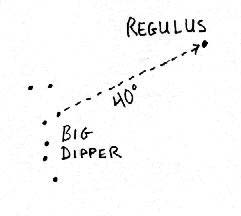
The centerpiece of the spring sky, Leo the Lion, sits high in the south early in the evening. Leo's head and chest are shaped like a sickle or a backward question mark, and his hindquarters are shaped like a triangle.

If these shapes are not apparent to you at first, you can use the Big Dipper to show the way. The pointer stars are the two stars on the side of the cup that attaches to the handle. Follow them in the direction from the handle toward the bottom of the cup for 40 degrees, or four fist widths. This will bring you to Regulus (REG-yoo-lus, meaning "prince"), the bright star at the bottom of the sickle. The triangle is to the left, about as far away as the height of the sickle.
You may recognize Leo as one of the constellations in the zodiac. Because our solar system is shaped like a flat disk, the sun, moon, and planets all appear to travel through the sky along a single line that circles through twelve constellations. The path they follow is called the ecliptic, and Regulus sits very close to this line.
Knowing where the ecliptic is makes it easier to identify planets, since they will be along the same line as the moon and Regulus. Two bright planets are visible in early- to mid-evening now. As you face south, the largest planet, Jupiter, is about 20 degrees to the right of Regulus along the ecliptic. Saturn is about 40 degrees beyond Jupiter. The moon also appears along the ecliptic line, but in a different location every day.
Jupiter is in the middle of the faint zodiacal constellation Cancer the Crab, and very near Cancer's most notable feature, the Beehive Cluster (M44, also known as the Manger or Praesepe.) From a dark location, you might be able to see the Beehive as a fuzzy spot even larger than the moon. Look at it through binoculars to see a loosely clustered group of individual stars that may remind you of the swarm of activity in a beehive.

The Piker Press moderates all comments.
Click here for the commenting policy.